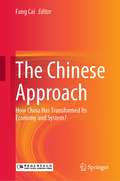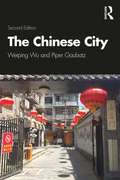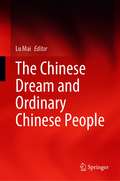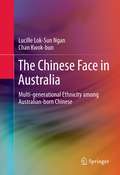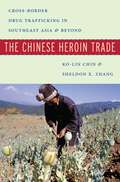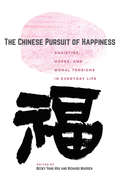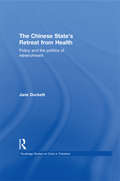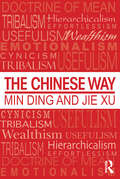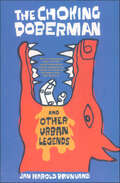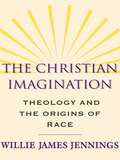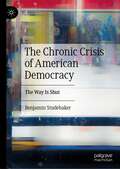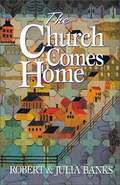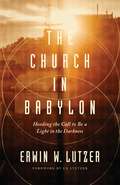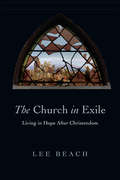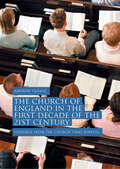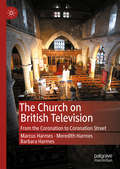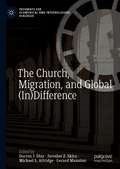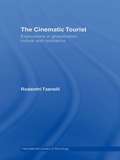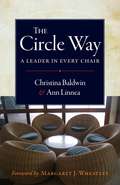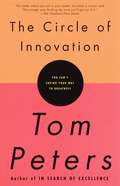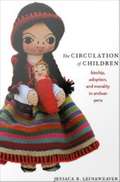- Table View
- List View
The Chinese Approach: How China Has Transformed Its Economy and System?
by Fang CaiThis volume introduces readers to the achievements made in the context of China’s reform and opening up. It tells China’s story with regard to twelve aspects: the reform path, opening up, macro-economy, regional development, the “three rural” policy, poverty alleviation, industrial development, scientific and technological leadership, ecological civilization, human resources, social security, and income distribution. On the one hand, China’s successes and lessons learned in this regard – e.g. the establishment of special economic zones and pilot zones in advance, followed by the implementation of regional development strategies – can be condensed into a general sense of Chinese wisdom. On the other, China’s participation in economic globalization and global economic governance can serve as a role model, helping developing countries overcome poverty and move towards modernization. As China accounts for nearly one fifth of the world’s total population, the problems and difficulties that it faced at the beginning of reform and opening up are similar to those of many developing countries; therefore, it can provide valuable guidance for developing countries in the form of Chinese wisdom and Chinese approach.
The Chinese City (A\world Bank Publication)
by Weiping Wu Piper GaubatzDrawing on years of research experience and keen observations of the triumphs and problems in China’s cities, the authors provide a foundational understanding of China’s urbanization and cities that is grounded in history and geography and challenges readers to consider Chinese urbanization through multiple disciplinary and thematic lenses. This book is anchored in the spatial sciences, including geography, urban studies, urban planning, and environmental studies. It offers a comprehensive survey of the evolving urban landscape, covering such topics as history and patterns of urbanization, spatial and regional context, models of urban form, economic and social-spatial transformation, urbanism and cultural dynamics, housing and land development, environmental and infrastructure issues, poverty and inequality, and challenges of urban governance. The book highlights both parallels and substantive differences between China and comparable cities and countries elsewhere, given that some urban conditions around the world converge and point to shared catalysts (e.g. internal migration) and globally linked processes (e.g. climate change). It explores the consequences of the demographic, economic, social, and environmental transitions on cities and urban dwellers. Illustrated case studies in each chapter ground the discussion and introduce readers to the diversity of cities and urban life in China. Most chapters also can be used as stand-alone course materials, with suggested references for further reading. Intended for a wide audience in higher education and beyond, this book will be useful to readers interested in Chinese Studies, East Asian Studies, Urban Studies, Urban Geography, or Urban Planning.
The Chinese Dream and Ordinary Chinese People
by Mai LuThis collection of interviews explores how the Chinese Dream is fueling the aspirations of individuals in China today and presents 40 representative cases that showcase the journeys that ordinary people undertake in pursuit of their dreams as well as their extraordinary achievements. The authors identify autonomy, self-awareness, and hard work as the most fundamental driving forces in individuals taking control of their own lives and achieving their dreams, with family and social support as further important factors. Despite the vast differences in the interviewees’ dreams and experiences in pursuing them, there is a common thread in their stories, namely the impact of major changes in the country on their lives. The future of individuals is closely linked to the future of the country: a bright future for the country means a good life for all. People’s longing for a better life is the basis and a central element of the Chinese Dream, which is the dream of the nation and the dream of every citizen. This book will appeal to a wide audience, including ordinary people.
The Chinese Dream: An Educational Philosophy and Theory Chinese Educational Philosophy Reader, Volume VII (Educational Philosophy and Theory: Editor’s Choice)
by Michael A. PetersThis edited collection is based on a series of articles written by Michael A Peters as Editor-in-Chief of Educational Philosophy and Theory to explore the concept of The Chinese Dream first introduced by President Xi in 2012. This seventh volume in the Editor's Choice series provides a philosophical and historical analysis of The Chinese Dream by analyzing its major intersecting narratives - liberal, Confucian and Marxist. With chapters covering higher education strategy, social governance, socialist rule of law, the US-China trade war, technological unemployment and the emergence of the Chinese techno-state, this volume also offers an introduction to Chinese philosophy and history, and its narrative re-crafting that presents China as a global power. The author calls this process and the emerging Chinese narratives 'Educating the Future'.
The Chinese Face in Australia
by Chan Kwok-Bun Lucille Lok-Sun NganThe book explains how multi-generational Australian-born Chinese (ABC) negotiate the balance of two cultures. It explores both the philosophical and theoretical levels, focusing on deconstructing and re-evaluating the concept of 'Chineseness.' At a social and experiential level, it concentrates on how successive generations of early migrants experience, negotiate and express their Chinese identity. The diasporic literature has taken up the idea of hybrid identity construction largely in relation to first- and second-generation migrants and to the sojourner's sense of roots in a diasporic setting somewhat lost in the debate over Chinese diasporas and identities are the experiences of long-term migrant communities. Their experiences are usually discussed in terms of the melting-pot concepts of assimilation and integration that assume ethnic identification decreases and eventually disappears over successive generations. Based on ethnography, fieldwork and participant observation on multi-generational Australian-born Chinese whose families have resided in Australia from three to six generations, this study reveals a contrasting picture of ethnic identification.
The Chinese Heroin Trade: Cross-Border Drug Trafficking in Southeast Asia and Beyond
by Ko-Lin Chin Sheldon X. ZhangIn a country long associated with the trade in opiates, the Chinese government has for decades applied extreme measures to curtail the spread of illicit drugs, only to find that the problem has worsened. Burma is blamed as the major producer of illicit drugs and conduit for the entry of drugs into China. Which organizations are behind the heroin trade? What problems and prospects of drug control in the so-called "Golden Triangle" drug-trafficking region are faced by Chinese and Southeast Asian authorities? In The Chinese Heroin Trade, noted criminologists Ko-Lin Chin and Sheldon Zhangexamine the social organization of the trafficking of heroin from the Golden Triangle to China and the wholesale and retail distribution of the drug in China. Based on face-to-face interviews with hundreds of incarcerated drug traffickers, street-level drug dealers, users, and authorities, paired with extensive fieldwork in the border areas of Burma and China and several major urban centers in China and Southeast Asia, this volume reveals how the drug trade has evolved in the Golden Triangle since the late 1980s. Chin and Zhang also explore the marked characteristics of heroin traffickers; the relationship between drug use and sales in China; and how China compares to other international drug markets. The Chinese Heroin Trade is a fascinating, nuanced account of the world of high-risk drug trafficking in a tightly-controlled society.
The Chinese Pursuit of Happiness: Anxieties, Hopes, and Moral Tensions in Everyday Life
by Richard Madsen Becky Yang HsuWhat defines "happiness," and how can we attain it? The ways in which people in China ask and answer this universal question tell a lot about the tensions and challenges they face during periods of remarkable political and economic change. Based on a five-year original study conducted by a select team of China experts, The Chinese Pursuit of Happiness begins by asking if Chinese citizens’ assessment of their life is primarily a judgment of their social relationships. The book shows how different dimensions of happiness are manifest in the moral and ethical understandings that embed individuals in specific communities. Vividly describing the moral dilemmas experienced in contemporary Chinese society, the rituals of happiness performed in modern weddings, the practices of conviviality carried out in shared meals, the professional tensions confronted by social workers, and the hopes and frustrations shared by political reformers, the contributors to this important study illuminate the causes of anxiety and reasons for hope in China today.
The Chinese State's Retreat from Health: Policy and the Politics of Retrenchment (Routledge Studies on China in Transition)
by Jane DuckettOver the post-Mao period, the Chinese state has radically cut back its role in funding health services and insuring its citizens against the costs of ill health. Using an analytical framework drawn from studies of state retrenchment in industrialized democracies and in post-communist Eastern Europe, Jane Duckett argues that the state’s retreat from health in China was not a simple consequence of economic policies and market reform. Just as important were the influences of health policies, reform era political institutions, communist party ideology, and bureaucratic stakeholders. Through her analysis, Duckett maintains that by studying retrenchment in China, the world’s most populous nation and now a major global economic power, we can better understand international transformations in the role of the state, and the politics that shape that role. The Chinese State’s Retreat from Health both extends research on retrenchment politics to a major authoritarian state and contributes to piecing together understanding of the Chinese state’s changing role across the economy and other social policies, including housing and education. It will be of interest to students and scholars of Chinese politics, social policy and the Chinese health care system, as well as to those with a comparative interest in health, welfare states and the politics of retrenchment. Jane Duckett is Professor of Chinese and Comparative Politics at the University of Glasgow, UK.
The Chinese Way: Walked Out Of The New Way Of Cancer Treatment With Immune Regulation And Control Of Combination Of Chinese And Western Medicine
by Min Ding Jie XuAs business becomes increasingly globalized and China establishes its growing role in the international business environment, developing an understanding of the complex culture is important to anyone acting in the global arena. This book offers readers a thorough and nuanced resource to that end, describing the ever-evolving Chinese way of life circa 2014, based on extensive primary and secondary data. Taking an anthropological approach to achieve a well-rounded representation, the book covers 51 topics that would have been studied if China were a newly discovered civilization. It explores the culture through its examination of the nine core concepts that best represent the Chinese way of life. While the book is a rigorous treatment of the Chinese way of life, it is also filled with personal stories and perspectives from close to 1000 successful Chinese from academia, business, and government. The Chinese Way equips international business students, scholars, and practitioners with a deep understanding of a society that is a major player in global business today and offers a foundation for successful business interactions with Chinese companies, organizations, and people.
The Chinese of Sukabumi: A Study of Social and Cultural Accommodation (Engaging Indonesia)
by Mely G. TanThis book explores the historical and contemporary experiences of the Chinese in Sukabumi, Indonesia, including their migration to the region, their economic activities, and their relationships with the local population. The book also examines the cultural practices of the Chinese in Sukabumi, including their religion, language, and traditions, and how they have adapted to the local culture. Through extensive research and analysis, the author provides a detailed account of the ways in which the Chinese of Sukabumi have navigated their place in Indonesian society, and the challenges they have faced in doing so. Presented as a co-published edition with Yayasan Pustaka Obor Indonesia, and released in memoriam to the late Mely G. Tan, this edition of The Chinese of Sukabumi honours this original comprehensive study of the social and cultural adaptation of the Chinese community in Sukabumi with the aim of bringing it to a wider international audience. It is an essential resource for scholars and students of Southeast Asian studies, as well as anyone interested in the cultural and social dynamics of the Chinese diaspora.
The Choking Doberman: And Other Urban Legends
by Jan Harold Brunvand"A wonderfully entertaining book of American folklore and humor."—Elaine Kendall, Los Angeles Times Book Review Professor Jan Harold Brunvand expands his examination of the phenomenon of urban legends, those improbable, believable stories that always happen to a "friend of a friend."
The Christian Imagination: Theology and the Origins of Race
by Willie James JenningsWhy has Christianity, a religion premised upon neighborly love, failed in its attempts to heal social divisions? In this ambitious and wide-ranging work, Willie James Jennings delves deep into the late medieval soil in which the modern Christian imagination grew, to reveal how Christianity's highly refined process of socialization has inadvertently created and maintained segregated societies. A probing study of the cultural fragmentation--social, spatial, and racial--that took root in the Western mind, this book shows how Christianity has consistently forged Christian nations rather than encouraging genuine communion between disparate groups and individuals. Weaving together the stories of Zurara, the royal chronicler of Prince Henry, the Jesuit theologian Jose de Acosta, the famed Anglican Bishop John William Colenso, and the former slave writer Olaudah Equiano, Jennings narrates a tale of loss, forgetfulness, and missed opportunities for the transformation of Christian communities. Touching on issues of slavery, geography, Native American history, Jewish-Christian relations, literacy, and translation, he brilliantly exposes how the loss of land and the supersessionist ideas behind the Christian missionary movement are both deeply implicated in the invention of race. Using his bold, creative, and courageous critique to imagine a truly cosmopolitan citizenship that transcends geopolitical, nationalist, ethnic, and racial boundaries, Jennings charts, with great vision, new ways of imagining ourselves, our communities, and the landscapes we inhabit.
The Christianity of Culture
by Liana ChuaIn this richly contextualized study, Liana Chua explores how a largely Christian Bidayuh community has been reconfiguring its relationship to its old animist rituals through the trope and politics of "culture. " Placing her ethnography in dialogue with developments in the nascent anthropology of Christianity, Chua argues that such efforts at "continuity speaking" are the product not only of Malaysian cultural politics, but also of conversion and Christianity itself. This book invites scholars to rethink the nature and scope of conversion, as well as the multifarious, yet distinctive, forms that Christianity can take.
The Chronic Crisis of American Democracy: The Way Is Shut
by Benjamin StudebakerThis book argues that American democracy is in crisis. The economic system is slowly subjecting Americans of nearly all income levels and backgrounds to enormous amounts of stress. The United States lacks the state capacity required to alleviate this stress, and politicians increasingly find that if they promise to solve economic problems, they are likely to disappoint voters. Instead, they encourage voters to blame each other. The crisis cannot be solved, the economy cannot be set right, and democracy cannot be saved. But American democracy cannot be killed, either. Americans can’t imagine any compelling alternative political systems. And so, American democracy continues on, in a deeply unsatisfying way. Americans invent ever-more elaborate coping mechanisms in a desperate bid to go on. But it becomes increasingly clear that the way is shut. The American political system was made by those who are dead, and the dead keep it.
The Church Comes Home: Building Community and Mission Through Home Churches
by Robert Banks Julia Banks"The Church Comes Home is a handbook for those interested in home churches. It is both visionary and practical. It describes how home churches can be formed, how they should grow, and how networks of home churches can develop. It examines issues - for example, how to make decisions; how to determine doctrine; how to include children, singles, elders; and how to reach out to the community at large - and offers practical suggestions for their resolution. "--BOOK JACKET. Title Summary field provided by Blackwell North America, Inc. All Rights Reserved
The Church in Babylon: Heeding the Call to Be a Light in the Darkness
by Erwin W. Lutzer<p>How do we live faithfully in a country becoming more and more hostile to our faith in Christ? <p>Like the Israelites in Babylon, we must find a way to maintain our faith in the midst of a pagan culture. But that requires we answer two crucial questions: <p> <li>How did we get here? <li>How do we prepare for the dark and difficult days ahead?</li> <p> <p>In The Church in Babylon, Dr. Lutzer answers both of these questions. He will walk you through the many parallels between the church in America and God's people in Babylon, and embolden you to be a gospel witness. You'll be encouraged not to compromise your faith even when under constant pressure from all corners of society. And more than all this you will have a fresh encounter with Jesus Christ, as you consider the biblical role of those in exile.</p>
The Church in the Barrio
by Roberto R. TreviñoIn a story that spans from the founding of immigrant parishes in the early twentieth century to the rise of the Chicano civil rights movement in the early 1970s, Roberto R. Trevino discusses how an intertwining of ethnic identity and Catholic faith equipped Mexican Americans in Houston to overcome adversity and find a place for themselves in the Bayou City. Houston's native-born and immigrant Mexicans alike found solidarity and sustenance in their Catholicism, a distinctive style that evolved from the blending of the religious sensibilities and practices of Spanish Christians and New World indigenous peoples. Employing church records, newspapers, family letters, mementos, and oral histories, Trevino reconstructs the history of several predominately Mexican American parishes in Houston. He explores Mexican American Catholic life from the most private and mundane, such as home altar worship and everyday speech and behavior, to the most public and dramatic, such as neighborhood processions and civil rights marches. He demonstrates how Mexican Americans' religious faith helped to mold and preserve their identity, structured family and community relationships as well as institutions, provided both spiritual and material sustenance, and girded their long quest for social justice.
The Church of England in the First Decade of the 21st Century: Findings From The Church Times Surveys
by Andrew VillageThis book analyzes two large surveys of clergy and lay people in the Church of England taken in 2001 and 2013. The period between the two surveys was one of turbulence and change, and the surveys offer a unique insight into how such change affected grassroots opinion on topics such as marriage, women’s ordination, sexual orientation, and the leadership of the Church. Andrew Village analyzes each topic to show how opinion varied by sex, age, education, location, ordination, and church tradition. Shifts that occurred in the period between the two surveys are then examined, and the results paint a detailed picture of how beliefs and attitudes vary across the Church and have evolved over time. This work uncovers some unforeseen but important trends that will shape the trajectory of the Church in the years ahead.
The Church on British Television: From the Coronation to Coronation Street
by Marcus Harmes Meredith Harmes Barbara HarmesThis book will be the first systematic and comprehensive text to analyze the many and contrasting appearances of the Church of England on television. It covers a range of genres and programs including crime drama, science fiction, comedy, including the specific genre of ‘ecclesiastical comedy’, zombie horror and non-fiction broadcasting. Readers interested in church and political history, popular culture, television and broadcasting history, and the social history of modern Britain will find this to be a lively and timely book. Programs that year after year sit enshrined as national favourites (for example Dad’s Army and Midsomer Murders) foreground the Church. From the Queen’s Christmas Message to royal weddings and Coronation Street, the clergy and services of England’s national church abound in television. This book offers detailed analysis of landmark examples of small screen output and raises questions relating to the storytelling strategies of program makers, the way the established Church is delineated, and the transformation over decades of congregations into audiences.
The Church, Migration, and Global (Pathways for Ecumenical and Interreligious Dialogue)
by Gerard Mannion Darren J. Dias Jaroslav Z. Skira Michael S. AttridgeThe painful reality faced by refugees and migrants is one of the greatest moral challenges of our time, in turn, becoming a focus of significant scholarship. This volume examines the global phenomenon of migration in its theological, historical, and socio-political dimensions and of how churches and faith communities have responded to the challenges of such mass human movement. The contributions reflect global perspectives with contributions from African, Asian, European, North American, and South American scholars and contexts. The essays are interdisciplinary, at the intersection of religion, anthropology, history, political science, gender and post-colonial studies. The volume brings together a variety of perspectives, inter-related by ecclesiological and theological concerns.
The Cinematic Tourist: Explorations in Globalization, Culture and Resistance (International Library of Sociology)
by Rodanthi TzanelliRecent years have seen a radical transformation of conventional tourist marketing and experience. The use of exotic locations in Hollywood films has allowed global audiences to enjoy distant places. Simultaneously, Hollywood screening of potential 'tourist paradises' has generated new tourist industries around the world. This book takes a closer look at this new phenomenon of 'cinematic tourism', combining theory with case studies drawn from four continents: America, Europe, Asia and Australasia. The author explores audiences' perceptions of film and their covert relationship with tourist advertising campaigns, alongside the nature of newly-born tourist industries and the reaction of native populations and nation-states faced with the commodification of their histories, identities and environments.
The Circle Way: A Leader in Every Chair
by Christina Baldwin Ann LinneaAn authoritative and accessible guide to this foundational form of collaborative decision-making Uses images, stories and step-by-step instructions to teach the basics of circle and explore it’s deeper meanings Written by two pioneers in reviving, standardizing and popularizing circle process More and more organizations are looking for alternatives to rigid, top-down hierarchy. Even the most old-school now realize that good ideas can come from anywhere and that fostering collaboration and group cohesion is vital to any healthy enterprise. But what approach can best create an environment that ensures clear speaking, compassionate listening, and the making of well-grounded decisions? The most ancient one: the circle. The circle was the form of original gathering that taught human beings how to create social patterns. All modern group processes open to collaboration or to flattening the hierarchy are based in some way on circle practices. Here two veteran practitioners offer a comprehensive guide to this foundational form of human interaction The Circle Way lays out the basics of circle conversation based on the original work of the coauthors, who have studied and standardized the essential elements of circle practice and have been implementing them in a variety of organizations for over fifteen years. It opens with a unique visual guide to circle and then presents both structure and story so that readers understand how these elements come into play and how they are interrelated and interactive. Baldwin and Linnea include detailed instructions and suggestions for getting started, setting goals, and solving conflicts. And they delve into the deeper aspects of circle, illuminating the profound transformation the process has on people who participate in it.
The Circle of Innovation: You Can't Shrink Your Way to Greatness
by Tom PetersTom Peters--brilliant, original, and perhaps the most inspiring and listened-to business thinker of our time--has a lot on his mind these days. And he wants to share it in The Circle of Innovation. The world of business is in a permanent state of flux, he argues, a state of chaos in which constant innovation is the only survival strategy--for the individual and for the organization. And he presents here a lifesaving handbook--both provocative and practical--designed to turn any organization into a perpetual innovation machine.In 400 seminars in 47 states and 22 countries in the last five years, Peters has reexamined, refined, and reinvented his views on innovation. Now he brings those seminars--and his passion--to the reader in a landmark book. It is meant, he writes, to both "terrify" and "enlighten." These are "times of matchless peril for those who fail to grasp the nettle...and times of matchless opportunity for those who do."To keep us alert, limber, and ready for action, he provokes and cajoles in chapter after chapter. Among his institutions and revelations:We Are All Michelangelos. He shows how to transform every "jobholder" into a full-fledged businessperson.All Value Comes from the Professional Services. How to convert sluggish staff units into Vital Centers of Intellectual Capital Accumulation.The System is the Solution. How to build great systems--which go far beyond nuts and bolts.Create Waves of Lust. Quality is not the automatic advantage it recently was. There is a pressing need to reverse the rising tide of product and service "commoditization."Tommy Hilfiger Knows. In a crowded marketplace, branding is far more important than ever before.It's a Woman's World. How to capitalize on the fact that women purchase/are purchasing agents for well over half of U.S. commercial and consumer goods.Little Things Are the Only Things. As the Blight of Sameness encroaches on market after market, design is often the best tool in services or manufacturing for sustainable differentiation.We're Here to Live Life Out Loud. Why transformational leaders of the future must have laser-like focus, tell the truth, and live on the lunatic fringe.The hallmarks of Tom Peters legend are an insatiable curiosity, an agile intellect, a pragmatic perspective, and an uncanny ability to gauge the global zeitgeist. These qualities are all brought to bear as Peters sets out to engage, enrage, and ultimately empower his readers, amid forces that are reshaping not only business but every aspect of human experience.
The Circulation of Children: Kinship, Adoption, and Morality in Andean Peru
by Jessaca B. LeinaweaverIn this vivid ethnography, Jessaca B. Leinaweaver explores "child circulation," informal arrangements in which indigenous Andean children are sent by their parents to live in other households. At first glance, child circulation appears tantamount to child abandonment. When seen in that light, the practice is a violation of international norms regarding children's rights, guidelines that the Peruvian state relies on in regulating legal adoptions. Leinaweaver demonstrates that such an understanding of the practice is simplistic and misleading. Her in-depth ethnographic analysis reveals child circulation to be a meaningful, pragmatic social practice for poor and indigenous Peruvians, a flexible system of kinship that has likely been part of Andean lives for centuries. Child circulation may be initiated because parents cannot care for their children, because a childless elder wants company, or because it gives a young person the opportunity to gain needed skills. Leinaweaver provides insight into the emotional and material factors that bring together and separate indigenous Andean families in the highland city of Ayacucho. She describes how child circulation is intimately linked to survival in the city, which has had to withstand colonialism, economic isolation, and the devastating civil war unleashed by the Shining Path. Leinaweaver examines the practice from the perspective of parents who send their children to live in other households, the adults who receive them, and the children themselves. She relates child circulation to international laws and norms regarding children's rights, adoptions, and orphans, and to Peru's history of racial conflict and violence. Given that history, Leinaweaver maintains that it is not surprising that child circulation, a practice associated with Peru's impoverished indigenous community, is alternately ignored, tolerated, or condemned by the state.
